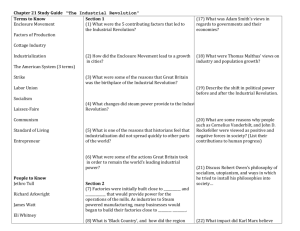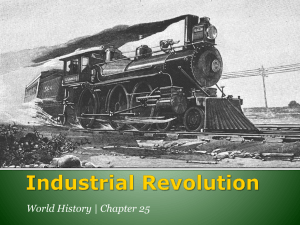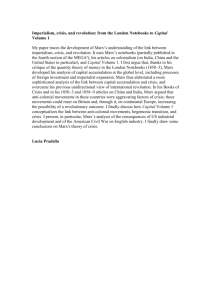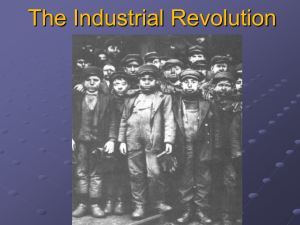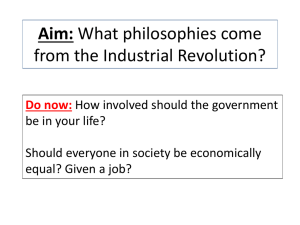Prelims Politics: Marx Lecture II
advertisement
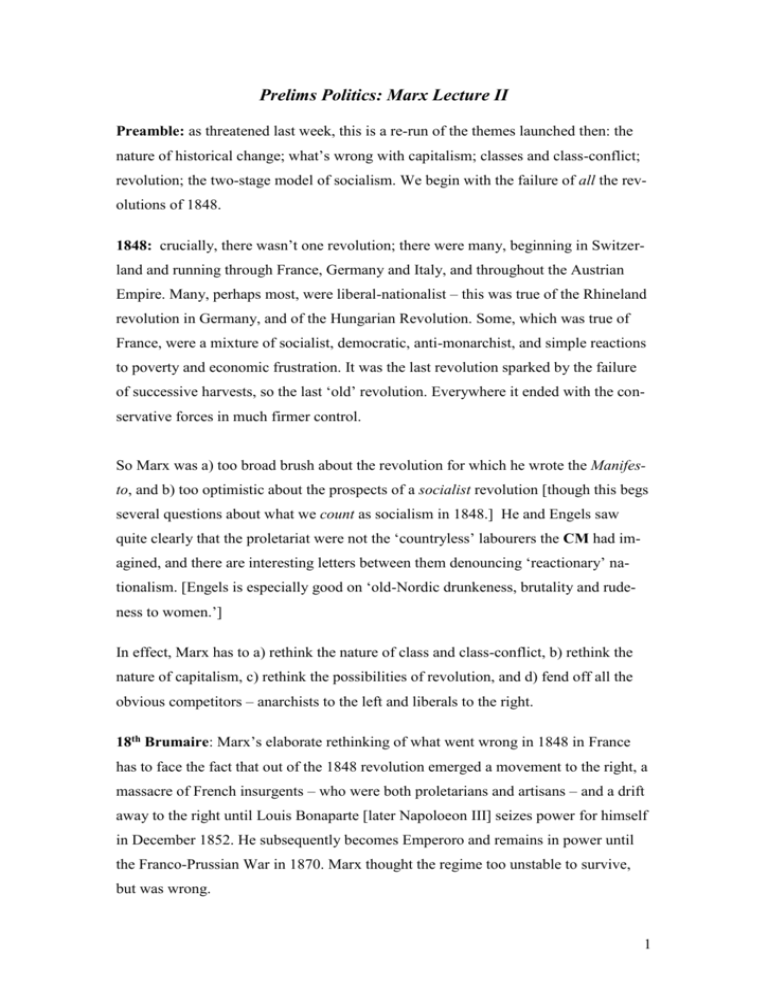
Prelims Politics: Marx Lecture II Preamble: as threatened last week, this is a re-run of the themes launched then: the nature of historical change; what’s wrong with capitalism; classes and class-conflict; revolution; the two-stage model of socialism. We begin with the failure of all the revolutions of 1848. 1848: crucially, there wasn’t one revolution; there were many, beginning in Switzerland and running through France, Germany and Italy, and throughout the Austrian Empire. Many, perhaps most, were liberal-nationalist – this was true of the Rhineland revolution in Germany, and of the Hungarian Revolution. Some, which was true of France, were a mixture of socialist, democratic, anti-monarchist, and simple reactions to poverty and economic frustration. It was the last revolution sparked by the failure of successive harvests, so the last ‘old’ revolution. Everywhere it ended with the conservative forces in much firmer control. So Marx was a) too broad brush about the revolution for which he wrote the Manifesto, and b) too optimistic about the prospects of a socialist revolution [though this begs several questions about what we count as socialism in 1848.] He and Engels saw quite clearly that the proletariat were not the ‘countryless’ labourers the CM had imagined, and there are interesting letters between them denouncing ‘reactionary’ nationalism. [Engels is especially good on ‘old-Nordic drunkeness, brutality and rudeness to women.’] In effect, Marx has to a) rethink the nature of class and class-conflict, b) rethink the nature of capitalism, c) rethink the possibilities of revolution, and d) fend off all the obvious competitors – anarchists to the left and liberals to the right. 18th Brumaire: Marx’s elaborate rethinking of what went wrong in 1848 in France has to face the fact that out of the 1848 revolution emerged a movement to the right, a massacre of French insurgents – who were both proletarians and artisans – and a drift away to the right until Louis Bonaparte [later Napoloeon III] seizes power for himself in December 1852. He subsequently becomes Emperoro and remains in power until the Franco-Prussian War in 1870. Marx thought the regime too unstable to survive, but was wrong. 1 But, what was it, and what was its class basis? Start with the simple model: two classes face each other, the ruling class imposes the property rights that suit its domination, and the state is the committee for managing the common interests of – in this case – the bourgeoisie. We’ll come back to why it’s a two-class model – ie why there aren’t others worth picking out – but nb that Marx knew well enough that there were many different social groupings, such a religious, racial, geographical etc., and lots of different occupations. The crux is embodying the crucial line of cleavage such that A must subordinate B. On that basis, the peasantry don’t count; as Engels said, they are a bag of potatoes. To count as a class, you need feet in the economy base and heads and arms in the political arena. Peasants lead timeless, repetitive, apolitical existences and therefore don’t count politically; they supply no dynamism either economically or politically. The model is Britain, though Marx was always interested in Germany primarily, and took the French radical as the image of the engaged worker. 1848 shows the error of the simple model. Marx identifies many more politically important groupings and therefore classes; the state is no longer a committee for managing the common interests of the bourgoeisie because there isn’t a common interest. There are three (at least) elements in the bourgeoisie: financial, industrial, and the radical petty-b; if the radical petty-b are moved across to join the upper working class – skilled artisans etc – as they should be politically, we have a divided bourgeoisie with divided interests. Under those conditions, the state itself develops an interest in preserving its military-bureaucratic structure – ie it is not a bourgeois republic in form or content – and ‘floats free’ of its class supports. The troublesome classes are the radical petty-b, and the skilled and unskilled workers who revolted in Paris; but French politics was dictated by what the peasantry did when it (briefly) had the vote; peasants divide between those with a lot of land who can employ others, those who don’t employ others but work their own land, and those who labour for others. Beneath all this is the canaille or lumpenproletariat. [A bit like social class E – unemployed, unemployable, and students…] The skill of Louis Buonaparte was in attracting the scum, and employing the army both to secure the loyalty of the peasantry and allow himself to be the strong man who could keep down the Parisian workers. 2 So: back to the drawing board. If the theory of history depends on a two-class antagonism, complexity in class-formation and political action means we must rethink the dynamism of history; then we need a theory of exploitation to explain how capitalism works; then we need another story about revolution, proletarian democracy and socialism. Here it is in dogmatic outline… 1. Marx never abandons the MCH; but it becomes much more elaborate and hard to nail down. Sometimes, the route from the economic base – forces and relations of production – to the superstructure – laws, politics, ideas etc – is very direct; this is what Marx thinks capitalism drives towards. But, there are many situations where it does not; for instance, under the ‘Asiatic Mode of Production’ there is no dynamism, no class conflict, no forward movement; there are peasant cultivators and assorted forms of princely rule, and craftsmen of one sort and another who never become an urban middle class. The MCH in effect is appealed to to explain why the simple version of the MCH doesn’t work. It makes an enormous difference, however; the GI model that runs steadily from tribal-classical-feudal-capitalist-socialist now becomes a network of multiple possibilities – eg that India develops only when the East India Company drags it into the modern world. [There are echoes both of Hegel and of H.S. Maine in all this.] 2. If the historical story is complicated, we still need an explanation of what is wrong with capitalism. This is provided by Marx’s theory of exploitation. Marx only reaches this when he writes Capital. The model in the early writings is based on the horrors of the division of labour; the later is based on the thought that dead labour exploits living labour. This is explained by the labour theory of value and Marx’s key concept of labour power. Labour is an activity; labour power is the ability to labour. The capitalist buys labour power; when it is used it is labour that imparts all the added value in production. That added value is appropriated by the capitalist without giving any return to the worker; the capitalist pays the full value of the worker’s labour power – so there is no robbery in the process of paying wages – but he gets more than he has paid for because the worker creates more value in working than has gone into creating his labour power. Whether this is unjust is a very large question; but it certainly means that profit is unpaid labour. [What is wrong with this is deeply interesting.] 3 3. How does this link to politics and thus to revolution? No simple answer, but basically, the cleavage is capital-labour, or owners-workers, exploiters-exploited; this is the binary opposition. Multiple visible divisions don’t affect the basic cleavage; and capitalism drives towards simplifying the class structure. [This is very deeply wrong as an empirical matter, and that is a very important fact about both Marx and capitalism.] So, we are always heading towards the crunch when the two-class model of the CM reasserts itself. But, there is an alternative to the ‘sharpening contradictions’ model, which is that of the obsolescence of capitalism: since workers can live without capitalists [though not without capital], one could imagine a steady shift towards socialism without either a general collapse of capitalism or a violent insurrection. This is known as ‘the parliamentary road to socialism,’ and the faint hint of revolution lies in the thought that once the workers have installed a socialist government, there will be a backlash from the expropriated capitalists and their allies, so that counter-revolution will need to be suppressed. 4. This gets us onto proletarian democracy. All states are clas states; all class states are dictatorships, not in the sense of being ruled by Pinochet or Hitler, but because they are ruled in the interests and by the agents of the dominant economic class. This is Marx’s way of distinguishing between their professed aim of ruling in the common interest and the actual aim of securing the class hegemoney of whichever class they serve. The interesting case is proletarian democracy; it is a dictatorship because it enforces the interests of the proletariat over those of the bourgeoisie; but it is also a democracy, because all that is needed for the proletariat to prevail is that the great mass of the population really rules. [Lenin, State and Revolution spells this out more effectively.] 5. The end of the process is the withering away of the state; absent class conflict, law and repression are unnecessary. All that is needed is the rational coordination of economic activity. The government of men gives way to the administration of things. There are innumerable – very interesting – questions about whether it can be done: can you administer things without governing men? Bakunin says no. Marx says Bakunin can’t distinguish government and management. History seems to side with Bakunin. 4 6. Socialism comes in two stages – see The Critique of the Gotha Programme – the first stage of which abolishes capitalists but still preserves many of the inequalities of capitalism: the principle is ‘to each according to productive capacity.’ Marx was fighting off socialists who wanted the whole product of labour to go the worker; rightly, he argued that it could not – besides depreciation and investment, there’d be something needed for education, health care and pensions; but the one thing that would not happen was a capitalist taking a profit. The workers need capital, not capitalists. [This is obviously true, but may not make as much difference as Marx hoped. The whole story is short of a view of entrepreneurship and management skill.] But the interesting issue is the transition between stage one and stage two; in the latter the narrow horizons of bourgeois right are transcended, and the principle on which it works is from each according to ability to each according to need. The principle was in fact put forward by St-Simon some fifty years before; now we are more likely to ask whether it is a principle of justice and if not what it might be… 5


